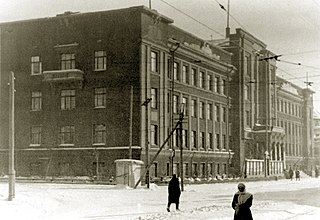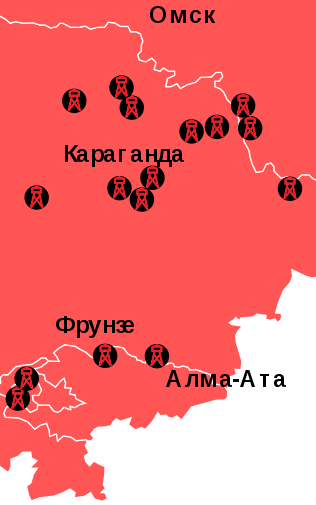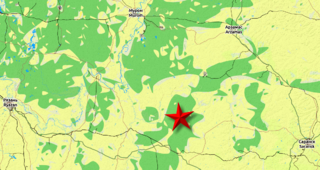
Norillag, Norilsk Corrective Labor Camp (Russian : Норильлаг, Норильский ИТЛ) was a gulag labor camp set by Norilsk, Krasnoyarsk Krai, Russia and headquartered there. It existed from June 25, 1935 to August 22, 1956. [1]

Norillag, Norilsk Corrective Labor Camp (Russian : Норильлаг, Норильский ИТЛ) was a gulag labor camp set by Norilsk, Krasnoyarsk Krai, Russia and headquartered there. It existed from June 25, 1935 to August 22, 1956. [1]
Initially, the Norillag labor force was responsible for the construction of the Norilsk mining-metallurgic complex and for mining copper and nickel. Its activities gradually expanded into virtually all economical functions of the region, from fishing to "reconstruction of the house where lived Comrade I.V. Stalin in exile". [1]
Starting from 1,200 inmates in 1935, its numbers jumped to 9,000 in 1937 (the onset of the Great Purge) and peaked in 1951 at 72,500, housed in 30 camp sections. Memorial estimates the total number of its inmates over the history of the camp at 400,000, with about 300,000 being political prisoners. The geography of this camp system included the Norilsk area, including Dudinka and Kayerkan, as well as more remote places, including Krasnoyarsk and some agricultural camps in Kureika (village), Atamanovo and Shushenskoye.
Initially the construction activities were handled by the Norilstroy (Норильстрой), while Norillag supplied the workforce and some infrastructure.
In 1953, shortly after the death of Joseph Stalin, the Gorlag camp of Norillag system was the place of the major Gulag revolt, known as the Norilsk uprising.
It was closed in 1957, together with most of the Gulag system. [2]


The Gulag was a system of forced labor camps in the Soviet Union. The word Gulag originally referred only to the division of the Soviet secret police that was in charge of running the forced labor camps from the 1930s to the early 1950s during Joseph Stalin's rule, but in English literature the term is popularly used for the system of forced labor throughout the Soviet era. The abbreviation GULAG (ГУЛАГ) stands for "Гла́вное Управле́ние исправи́тельно-трудовы́х ЛАГере́й", but the full official name of the agency changed several times.

Sharashkas were secret research and development laboratories operating from 1930 to the 1950s within the Soviet Gulag labor camp system, as well as in other facilities under the supervision of the Soviet secret service. Formally various secret R&D facilities were called "special design bureau" Russian: особое конструкторское бюро, ОКБ and similar terms. Etymologically, the word sharashka derives from a Russian slang expression sharashkina kontora,, an ironic, derogatory term to denote a poorly-organized, impromptu, or bluffing organization, which in its turn comes from the criminal argot term sharaga (шарага) for a band of thieves, hoodlums, etc.)

Butyrskaya prison, usually known simply as Butyrka, is a prison in the Tverskoy District of central Moscow, Russia. In Imperial Russia it served as the central transit prison.

The Solovki special camp, was set up in 1923 on the Solovetsky Islands in the White Sea as a remote and inaccessible place of detention, primarily intended for socialist opponents of Soviet Russia's new Bolshevik regime.

Kolyma or Kolyma Krai is a historical region in the Russian Far East that includes the basin of Kolyma River and the northern shores of the Sea of Okhotsk, as well as the Kolyma Mountains. It is bounded to the north by the East Siberian Sea and the Arctic Ocean, and by the Sea of Okhotsk to the south. Kolyma Krai was never formally defined and over time it was split among various administrative units. As of 2023, it consists roughly of the Magadan Oblast, north-eastern areas of Yakutia, and the Bilibinsky District of Chukotka Autonomous Okrug.

Norilsk is a closed city in Krasnoyarsk Krai, Russia, located south of the western Taymyr Peninsula, around 90 km east of the Yenisey River and 1,500 km north of Krasnoyarsk. Norilsk is 300 km north of the Arctic Circle and 2,400 km from the North Pole. It has a permanent population of 176,735 as of 2024, and up to 220,000 including temporary inhabitants. It is the second-largest city in the region after Krasnoyarsk. Since 2016, Norilsk's population has grown steadily. In 2017, for the first time, migration to the city exceeded outflow. In 2018, according to Krasnoyarskstat, natural population growth amounted to 1,357 people: 2,381 were born, and 1,024 died.

Eufrosinia Antonovna Kersnovskaya was a Russian woman who spent 12 years in Gulag camps and wrote her memoirs in 12 notebooks, 2,200,000 characters, accompanied with 680 pictures.
Walter Joseph Ciszek, S.J. was a Polish-American Jesuit priest of the Russian Greek Catholic Church who clandestinely conducted missionary work in the Soviet Union between 1939 and 1963.
Nikolay Nikolayevich Urvantsev was a Soviet geologist and explorer. He was born in the town of Lukoyanov in the Lukoyanovsky Uyezd of the Nizhny Novgorod Governorate of the Russian Empire to the family of a merchant. He graduated from the Tomsk Engineering Institute in 1918.

Dmitry Nikolaevich Medvedev was one of the leaders of the Soviet partisan movement in western Russia and Ukraine.

Sevvostlag was a system of forced labor camps set up to satisfy the workforce requirements of the Dalstroy construction trust in the Kolyma region in April 1932. Organizationally being part of Dalstroy and under the management of the Labor and Defence Council of Sovnarkom, these camps were formally subordinated to OGPU later the NKVD directorate of the Far Eastern Krai. On March 4, 1938, Sevvostlag was resubordinated to the NKVD GULAG. In 1942 it was resubordinated back to Dalstroy. In 1949 it was renamed to the Directorate of Dalstroy Corrective Labor Camps. In 1953, after the death of Joseph Stalin, with the reform of the Soviet penal system, it was again resubordinated to Gulag and later reformed into the Directorate of Far Eastern Corrective Labor Camps Управление Северо-восточных исправительно-трудовых лагерей, УСВИТЛ (USVITL).

Nikolai Vekšin was a Russian and Estonian sailor and helmsman of the bronze-medallist Estonian team at the 1928 Amsterdam Olympic Games.
The Norilsk uprising was a major strike by Gulag inmates in Gorlag, a MVD special camp for political prisoners, and later in the two camps of Norillag [ITL], Norilsk, USSR, now Russia, in the summer of 1953, shortly after Joseph Stalin's death. About 70% of inmates were Ukrainians, some of whom had been sentenced for 25 years because of MGB accusations of being involved in the "Bandera standard". It was the first major revolt within the Gulag system in 1953–1954, although earlier numerous cases of unrest in Gulag camps are known. It was led by Pavel Frenkiel in 1st camp, by Boris Shamaev in 3rd camp, by Yevhen Hrytsyak in 4th camp, by Pavel Filnev in 5th camp and by Lesya Zelenska in 6th camp.

Karlag was one of the largest Gulag labor camps, located in Karaganda Oblast, Kazakh SSR, USSR. It operated during 1930—1959.

The Dubravny Camp, Special Camp No.3, commonly known as the Dubravlag, was a Gulag labor camp of the Soviet Union located in Yavas, Mordovia from 1948 to 2005.
Gorlag or Gorny Camp Directorate, Special Camp No. 2 ) was an MVD special camp for political prisoners within the Gulag system of the Soviet Union. It was established on February 28, 1948 on the part of the premises of Norillag, Norilsk, Krasnoyarsk Krai, RSFSR. In 1954, after Stalin's death it was merged back into Norillag, which was closed in 1957 together with most of the Gulag system.

The following lists events that happened during 1953 in the Union of Soviet Socialist Republics.

The Inta Corrective Labor Camp or Intalag was a forced labor camp of the Gulag, which existed between 1941 and 1948 near the town of Inta in the Komi Autonomous Soviet Socialist Republic. Prisoners at the camp were mainly engaged in the mining of local coal deposits.
Aleksandra Matveena Zelenskaya was a political prisoner in the gulag system of the Soviet Union who was the leader of the Norilsk uprising of the 6th Women's Camp at Gorlag.